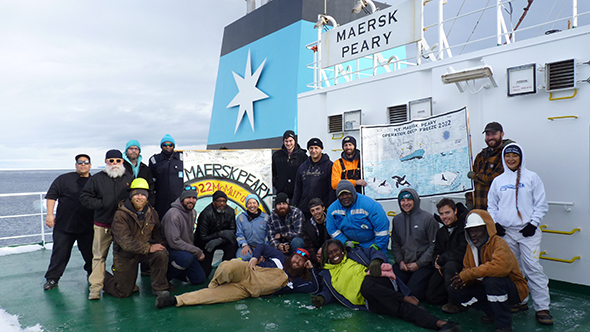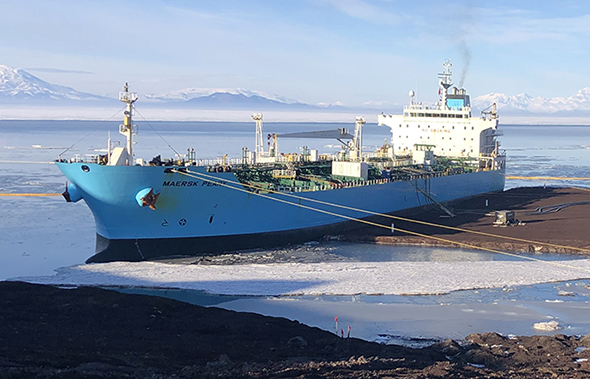Maersk Peary participates in fuel delivery for Operation Deep Freeze 2022

American Maritime Officers members working aboard the Maersk Peary during Operaton Deep Freeze 2022 in February included Chief Mate Trevor Fouhey, First Assistant Engineer Paul Styx, Third Mate Gemma Nguyen, Third A. E. Caleb Linder, Second A.E. Phillip Ianozi, Captain Everett Hatton, Second Mate Samuel Este, Chief Engineer Dimiter Mitev and Third Mate John McMonagle.
The following is excerpted from an article by Sarah Burford, Military Sealift Command Pacific.
Near the South Pole, the Military Sealift Command chartered ship M/T Maersk Peary is offloading nearly 9 million gallons of diesel and jet fuel at McMurdo Station, Antarctica. The operation is part of MSC's annual resupply mission in support of Operation Deep Freeze, the Joint Task Force Support for Antarctica mission to resupply the remote scientific outpost.
The crew of Peary are working with Seabees from Navy Cargo Handling Battalion ONE (NCHB-1) to offload their fuel cargo at the newly constructed ice-pier, ensuring all safety precautions are taken to protect the ship's crew and cargo handlers, as well as Antarctica's fragile environment. The fuel delivery will sustain McMurdo station for the next year.
While working in the remote environment of Antarctica is an adventure, Peary's adventures came as it traveled to the ice. In Greece, where the ship's journey originated, Peary participated in a search and rescue operation. Peary's crew sighted a survivor with their search lights, in the cold water, in the middle of the night, and recovered them with a rescue craft.
They then made it through the pirate infested waters of Red Sea and Gulf of Aden, followed by a stop in Fremantle, Australia, where due to COVID-19 restrictions, the crew was not allowed to leave the ship.
In past years, the trip across Southern Ocean has been treacherous, due to the thick ice pack. According to Captain Everett Hatton, Peary's civilian master, this year, the ship was able to easily make the crossing into Winter's Bay, where McMurdo Station is located.
"Continuous scrutiny of weather maps and forecasting to find safest routing for dangerous crossings, and having eagle eyes in the ice passage, and locating the lone icebergs kept us safe," said Hatton. "We were delighted to find not much pack ice to navigate through all the way to Winter's Quarter Bay."
Once at McMurdo Station, the crew's attention shifted from the journey to the mission of delivering fuel. According to Hatton, this isn't as easy as just pumping fuel from the ship to a storage facility. The extreme temperatures and the geography make this extremely challenging, not to mention the safety and security hazards of the natural environment.
"In such a pristine environment, we have to be extra careful of having not even a drop of any oil or lubricants being accidentally spilled," explained Hatton. "Keeping all equipment continually warmed up puts more planning and work hours in effect. For our engineers, the careful considerations of not getting parts or technicians in such a remote place as the continent of Antarctica keeps them always double checking equipment for any issues that may arise."
Peary is no stranger to the ODF mission, having made the fuel delivery over several years. Because of this, Hatton explained that he leaned on his lessons to know how to prepare for this year's mission, and how to anticipate issues that he has encountered in the past.
As Hatton and other people who have supported the ODF mission attest, working in the harsh environment of Antarctica is unlike any other and extremely challenging. Bitterly cold temperatures and harsh winds are physically challenging. Working at "The Bottom of the World" means feelings of isolation as well. Lack of access to the internet means no news, no social media access and no communication with family and friends. This can be hard for many young mariners to accept.
"Having younger and younger crews each year, I have noticed more dependence on social media of the crew. So on this trip to remoteness where there is no internet for weeks on end seems to add a degree of loneliness," said Hatton. "The weather can get extreme and the crew have to find within themselves a new endurance for days on end of extreme motions. Outside watches can really temper one's endurance."
Despite the challenges of the mission, Hatton recognizes the positive aspects of the ODF mission, noting that crew members who make the trip take away a new sense of accomplishment and pride.
"Having endured a Southern Ocean crossing leaves an impact of conquering one of the toughest passages known on earth," he said. "Dealing with extreme conditions and cold leave a memory for sure. Being proud of one's self, knowing that they have done what other great explores are known for, even if on more modern and safer vessels."
In addition to a feeling of accomplishment, Hatton and his crew will also have the honor of being the last Peary crew to complete an ODF mission, as the ship is scheduled to be rotated out of the Maersk fleet later this year.
Operation Deep Freeze is a joint service, on-going Defense Support to Civilian Authorities activity in support of the National Science Foundation (NSF), lead agency for the United States Antarctic Program. Mission support consists of active duty, Guard and Reserve personnel from the U.S. Air Force, Navy, Army, and Coast Guard as well as Department of Defense civilians and attached non-DOD civilians. ODF operates from two primary locations situated at Christchurch, New Zealand and McMurdo Station, Antarctica. 2022 marks MSC's return to support of ODF which was paused in 2021 due to the COVID-19 global pandemic. An MSC-chartered cargo ship and tanker have made the challenging voyage to Antarctica every year since the station and its resupply mission were established in 1955.

The Maersk Peary arrives at the McMurdo Station ice pier for cargo operations as part of Operation Deep Freeze 2022.
